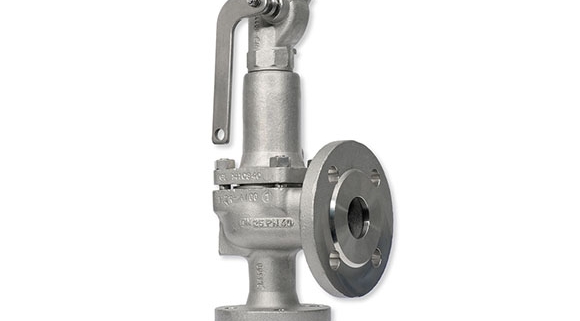Safety Valve
Safety Valve
Safety valve is a valve that acts as a protection of equipment from exploding or damaging and it is mainly installed in pressure vessels such as chemical plants, electric power boilers, and gas storage tanks.
Safety Valve is a type of valve that automatically actuates when the pressure of inlet side of the valve increases to a predetermined pressure, to open the valve disc and discharge the fluid (steam or gas); and when the pressure decreases to the prescribed value, to close the valve disc again. Safety valve is so-called a final safety device which controls the pressure and discharges a certain amount of fluid by itself without any electric power support.
Safety valve support not only the safety of the energy industry but also the safety and security of our life.
Start to Discharge Pressure
The inlet pressure at which the safety valve actually starts to discharge and outflow of an extremely small quantity of fluid (steam or gas) are detected at the outlet. The extremely small quantity means a minimum amount of visually or audibly detectable steam, or a minimum amount of gas that can be detected audibly or by using a soap solution. The outflow does not mean the leakage from the valve seat.
Opening Pressure
The inlet pressure at which the valve disc “Pops.” The opening pressure is also called “popping pressure.” “Popping” is an action of discharging fluid inside the valve due to the sudden rise of the valve disc.
Set Pressure
The opening pressure or start to discharge pressure determined in designing.
Closing Pressure
The inlet pressure fell down to the level at which the valve disc and the valve seat are in contact and the lift becomes zero. It is also called “reseating pressure.”
Blowdown
The difference between opening pressure or start to discharge pressure and closing pressure
Over Pressure
The increasing pressure exceeds the set pressure of the safety valve.
Allowable Over Pressure
The overpressure within the allowable range.
Coefficient of Discharge
The coefficient used to calculate the actual discharge capacity from the theoretical discharge capacity. The coefficient is the ratio between the two capacities, and it counts the frictional resistance.
Certified Derated Coefficient of Discharge
The coefficient of discharge to be applied to calculate the certified capacity.
Flow Rating Pressure
The inlet pressure is taken as the basis for determining the certified capacity of the safety valve, which is the sum of the set pressure and the allowable overpressure.
Back Pressure
The pressures existing at the outlet of the safety valve. There are two types as the following: (a) Accumulated back pressure: The pressure existing at the outlet of a safety valve caused by the resistance of the outlet side when the safety valve has been relieved. (b) Existing back pressure: The pressure which has already been superimposed at the outlet before the safety valve is relieved.
Theoretical Discharge Capacity
The discharge capacity calculated supposing that the fluid is free from friction and its flow rate coefficient is 1, and that the valve discharges the ideal gas of fixed specific heat with isentropic change.
Lift
The amount of travel, in the axial direction of the valve or valve rod, away from the closed position to the opened position during discharge of the safety valve
Safety valves protect steam systems and tanks from excess pressure. As they are often the last link in the safety chain, they must remain operational in all conditions.
Safety valves discharge water vapor, neutral gas, steam, and fluid in the event of excess pressure. As soon as normal operating conditions are restored, they close and do not release any more medium.
Feature
Full bore type
- Flanged
- Cast Iron
- Closed type
Application
- Steam
- Air
- Other non-dangerous fluids
Working pressure
- 0.045 – 1.6 MPa (20-100A) , 0.045 – 1.25 MPa (125A) , 0.045 – 1.0 MPa (150A) , According to PT rating
Max Temperature
- 250 degree C
Body
- Cast Iron
Spring chamber
- Ductile Cast Iron
Valve
- Stainless steel
Valve seat
- Stainless steel




Leave a Reply
Want to join the discussion?Feel free to contribute!